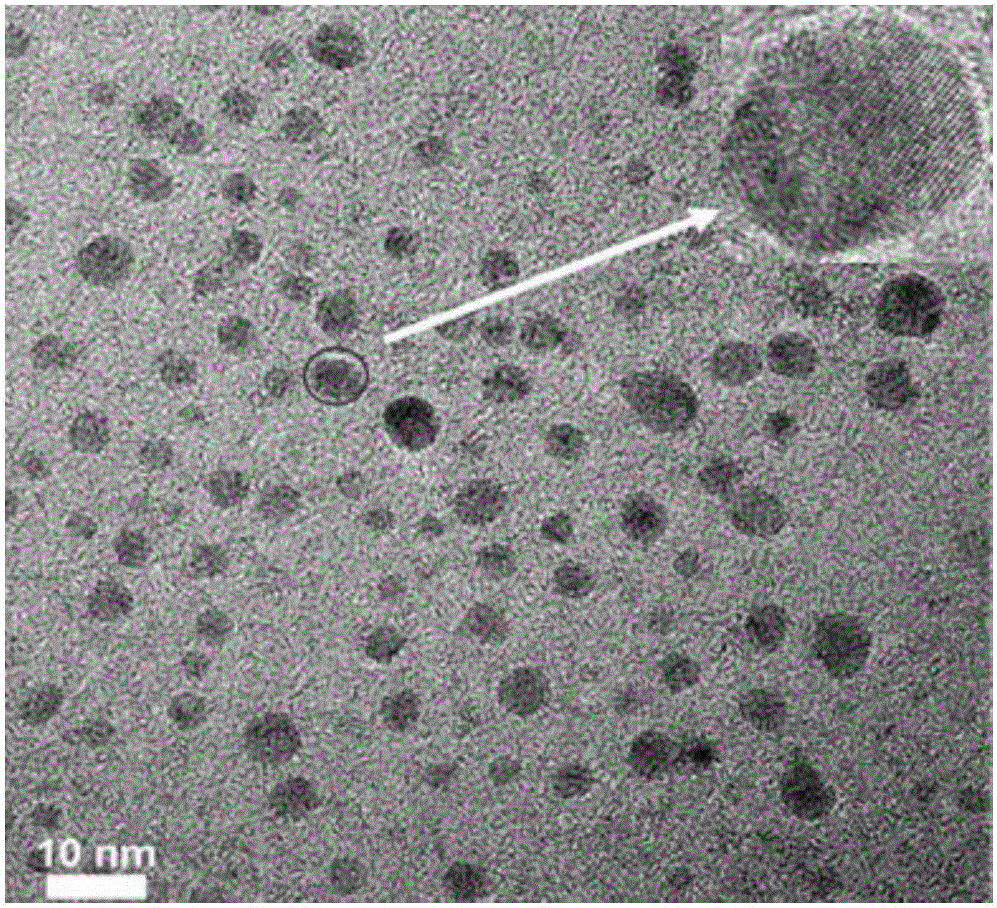High-quantum-yield eigenstate-fluorescence-adjustable carbon dot and preparing method and application thereof
An eigenstate, high-quantum technology, applied in luminescent materials, chemical instruments and methods, electrical components, etc., can solve problems such as low performance of light-emitting diode devices, limited effective carrier injection, and changes in fluorescence emission peaks, etc., to achieve The effect of high yield, high crystallinity and simple method
- Summary
- Abstract
- Description
- Claims
- Application Information
AI Technical Summary
Problems solved by technology
Method used
Image
Examples
Embodiment 1
[0044] Example 1. Preparation of intrinsic blue carbon dots with a quantum yield of 75%
[0045] Weigh 0.01 g each of 2,3-diaminonaphthalene and citric acid solids with a mass ratio of 1:1, and dissolve them in 10 ml of ethanol under ultrasonic stirring. 0.1ml of concentrated sulfuric acid was added to the reaction system as a reaction catalyst. Transfer the above solution to a 25ml polytetrafluoroethylene lined stainless steel autoclave, and tighten the lid. Solvothermally react at 140℃ for 4 hours, then let the reaction kettle cool to room temperature naturally to obtain a light yellow carbon dot ethanol solution, then neutralize to neutral with 20ml 0.01 mole per liter sodium hydroxide aqueous solution, then filter Take the filtrate and place it in a dialysis bag (1000Da) and dialyze it in deionized water for two days, changing the deionized water every three hours. After the dialysis, the solution in the dialysis bag is collected and freeze-dried to obtain the carbon dot so...
Embodiment 2
[0049] Example 2. Preparation of intrinsic green carbon dots with a quantum yield of 73%
[0050] The specific steps are the same as in Example 1, except that the precursor 2,3-diaminonaphthalene and citric acid solid are 0.1 and 0.01 g, respectively, the mass ratio is 10:1, the reaction temperature is 180° C., and the solvothermal reaction time is 9 hours. The resulting dilute ethanol solution of carbon dots emits bright green fluorescence under a portable ultraviolet lamp (365nm), and the green carbon dots exhibit excitation-independent intrinsic state fluorescence characteristics ( Picture 10 ), the emission peak is at 513nm. Green carbon dots have high crystallinity, with an average particle size of 2.41nm ( Picture 11 ). The measured absolute fluorescence quantum yield is as high as 73%.
Embodiment 3
[0051] Example 3. Preparation of intrinsic state yellow carbon dots with a quantum yield of 58%
[0052] The specific steps are the same as in Example 1. The difference is that the precursors are 1,5-diaminonaphthalene and citric acid, the masses are 0.04 and 0.01g, respectively, the mass ratio is 4:1, and the volume-to-mass ratio of ethanol to carbon source precursor is mL / The mg is 1:5, the reaction temperature is 200°C, and the solvothermal reaction time is 9 hours. The resulting dilute ethanol solution of carbon dots emits bright yellow fluorescence under a portable ultraviolet lamp (365nm), and the yellow carbon dots exhibit excitation-independent intrinsic state fluorescence characteristics ( Picture 12 ), the emission peak is at 535nm. Yellow carbon dots have high crystallinity, with an average particle size of 3.78nm ( Figure 13 ). The measured absolute fluorescence quantum yield is as high as 58%.
PUM
| Property | Measurement | Unit |
|---|---|---|
| size | aaaaa | aaaaa |
| particle size | aaaaa | aaaaa |
| luminance | aaaaa | aaaaa |
Abstract
Description
Claims
Application Information
 Login to View More
Login to View More - R&D
- Intellectual Property
- Life Sciences
- Materials
- Tech Scout
- Unparalleled Data Quality
- Higher Quality Content
- 60% Fewer Hallucinations
Browse by: Latest US Patents, China's latest patents, Technical Efficacy Thesaurus, Application Domain, Technology Topic, Popular Technical Reports.
© 2025 PatSnap. All rights reserved.Legal|Privacy policy|Modern Slavery Act Transparency Statement|Sitemap|About US| Contact US: help@patsnap.com



